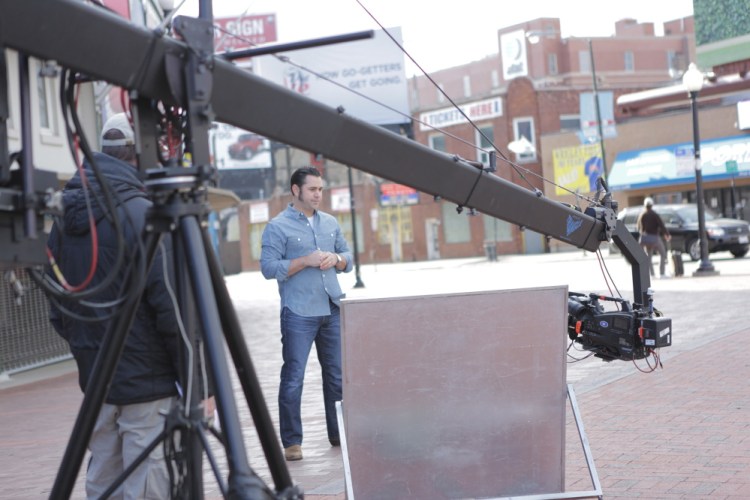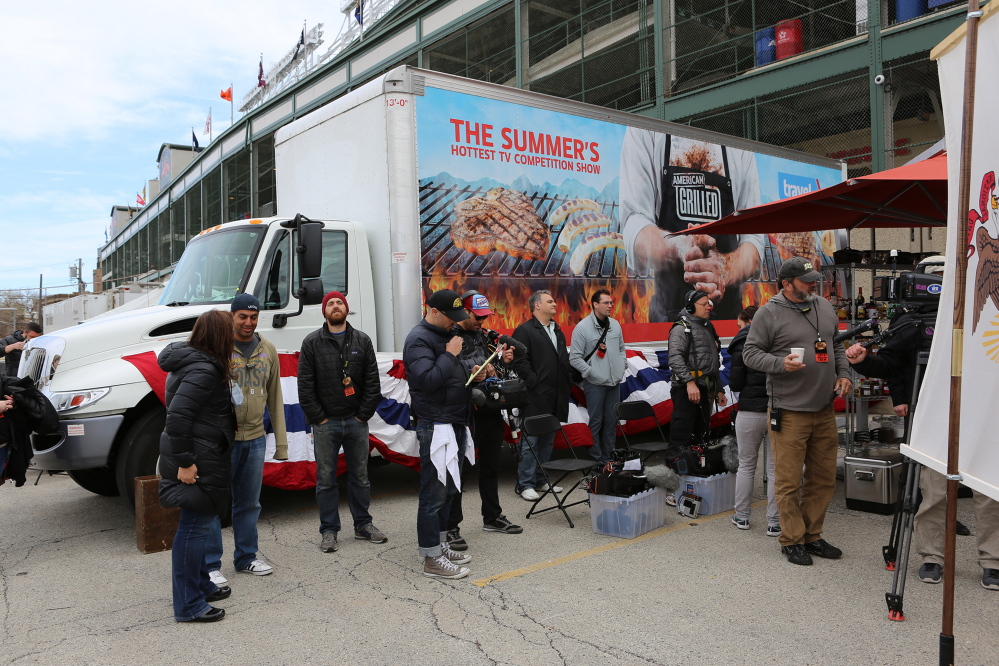All eyes are on the giardiniera.
After making the cut and practicing with likely ingredients, after surviving two quick rounds in which Cracker Jack, Vienna Beef franks, smoked cheese, deep-dish pizza dough and kielbasa had to be charred into cohesive, edible submission, it has come to this: A contestant has left a jar of Italian pickled vegetables – a must-use ingredient – untouched. In tortured unison, onlookers count down the final seconds.
The tension in the air is as thick as a 2-inch T-bone, which also happens to be a mandatory ingredient – the one that commanded most of the contestant’s attention. Does the contestant realize it yet? See the forgotten relish that might end up costing a cool 10 grand?
It’s not happening on some highfalutin studio set. The competition in this new show, called “American Grilled,” has wound tight through 11 hours of a changeable Chicago spring day, outside the main entrance to Wrigley Field.
Its host is no buttoned-down big shot. Anchoring the judge’s table is David Guas, all sideburns and denim and muy macho voice. Back at his Bayou Bakery in Arlington, Virginia, weeks after filming in 13 cities, he’s able to admit that, yes, there was something “pretty bad-ass” about the experience.
“I had this surrogate, adopted family” that was the production company, the usually humble chef says. “The more they shot, the more they understood who I was.”
If the chef fits.…
Whether or not America needs another competitive cooking show, programmers keep stuffing time slots with them. Those that feature spatula wars outdoors, with fire, have coast-to-coast appeal, perhaps because they highlight regional styles. Or because we, the people, are drawn to smoke. In any case, the brains behind “American Grilled” on the Travel Channel are certain they’ve got a contender.
“It’s my favorite show,” says Patrick McManamee, the Travel Channel executive producer responsible for fun fests such as “Xtreme Waterparks” and “Bikinis & Boardwalks.” Headset disengaged for the moment, he is on location at Wrigley, an eager adviser at the command-monitor setup dubbed Video Village. “When I saw David grilling burgers in a guest shot on ‘Today,’ I knew he was our guy.”
The concept: “American Grilled” rolls into town. Guas is the sole recurring member of a judging panel that includes a barbecue personality and a relevant local figure.
Four self-proclaimed “grilling geeks” from the area must cook with products from local purveyors and can draw from a pantry of staples and carefully curated, local fresh foods. Video footage and references to the city will reinforce the network’s brand.
Neil P. DeGroot, who with his wife owns a farm near North Carolina’s Great Smoky Mountains and feels passionately about the farm-to-table movement, is another reason McManamee is so keen. Watchers of TV credits have seen DeGroot’s name scroll by on eight seasons of “The Biggest Loser.” He has earned two Directors Guild of America awards; a bystander on the set can see how many hats DeGroot wears and how well he wears them. For this gig, he’s executive producer of Original Media, the production company hired to film “American Grilled.”
He and McManamee “spitballed and theorized” about the show; could someone even complete a grilled dish in 20 minutes? DeGroot recommended unexpected locations. Other places on “American Grilled” besides Chicago: Annapolis; Charlottesville; Asheville, N.C.; Jacksonville, Fla.; Pensacola, Fla.; Louisville; St. Louis; Savannah, Ga.; New Orleans; Memphis; Austin; and Latrobe, Pa.
“The city itself is a character. The show is regional and the food is local,” DeGroot says. “That’s what sets us apart.” He was also adamant that the process be “organic.” Contestants cook in real time. They suffer no character arcs or trash talk. Judges decide who wins.
As comfortable as Guas is on the small screen – he has appeared on “Today” 20 times since 2001, plus on various Food Network gigs – hosting has not been a cakewalk.
“The first three cities were bumpy,” he says. Shooting for “American Grilled” began last summer, and Guas was hired a mere two weeks prior. A format in which he chatted up contestants during each round was scrapped. It was too distracting for them, and too much like “those other shows.” He had to learn how to handle seven or eight pages of script yet exude an off-the-cuff vibe.
Mostly, he was reminded by DeGroot that the host’s on-camera work was not like the contestants’. ” ‘Dude, if ain’t right, we can do it again,’ is what he reinforced through that bug in my ear,” the 39-year-old chef says.
Guas’ own posse got to visit Latrobe, the last shoot. It’s safe to say that his publicist wife, Simone Rathle, has summoned all her professional acumen to help navigate her husband’s career. She’s his biggest fan.
Elder son Spencer, almost 12, says: “My father’s my father. That won’t change. He’ll always come to my baseball games” – although the rising seventh-grader says that when his teacher “unexpectedly did a report in class about my father having his show, it was cool.” Nine-year-old son Kemp wonders, “Now, is a limousine going to come and take us to school?”
PULLING IT ALL TOGETHER
The third-round giardiniera drama in Chicago seems like small potatoes compared with all that production manager Mo Krishna has to deal with. The 38-year-old Windy City native works 12-hour-plus days for weeks at a time.
He scouts locations before the talent arrives and is responsible for a 30-person staff and the equipment that fits into one 25-foot truck, a 14-foot camera truck, a nine-foot “grip” truck, a cargo van, a jib trailer and five traveling vehicles. That’s how this Original Media team rolls, a separate entity hired by the Travel Channel.
“The crew we have is almost perfect,” Krishna says. He is inexplicably laid back, wearing a hoodie and backward cap. He takes small delight in pointing out the look-closer feature on the side of the largest truck, which doubles as a backdrop for this location. Its “American Grilled” mural, a mashup of flames and grates and grill-marked foods, sports bratwurst that are, in fact, bananas – the work of some graphics artist, Krishna guesses.
DeGroot gets to see the big picture because his production manager keeps tabs on just about everything else. Their admiration for each other is genuine, and mutual.
The routine is the same for each town: a day of prep, a day to shoot, a day to wrap. Permission to film in the shadow of the Ernie Banks statue at Wrigley took Krishna four weeks to secure.
On this day he also has to play host to the MLB representatives on hand to make sure all baseball references were on the money. (No “s” at the end of Cracker Jack, they murmur at one point behind DeGroot in the Video Village, where a bank of mini-monitors shows all camera points of view. Another take, the host hears in his ear.)
Meanwhile, culinary director Clifford Endo Gulibert has scouted the local food scene and crowd-sourced for items that make sense for the episode. The trained chef in the porkpie hat has stocked all manner of kitchen appliances and utensils.
He has culled beautiful produce from the farmers market. He has filled a mega-cooler with marrow bones, pancetta, eggs, cheeses and beer, and can’t wait for the semi-finalists to tackle those Flinstonian T-bone steaks.
After each round, Gulibert pulls out styling tweezers to clean up the contestants’ plates, ever so subtly, for camera closeups. At the end of the shoot he gets to play Santa, dispensing unused food and beverages.
Meanwhile, the contestants are sequestered. Today that happens to be at the McDonald’s across the street. It’s tough to envision how those golden arches will play in post-production.
Krishna hired a local medic to be on the set all day. He has made sure that concrete weights prevent the wide umbrellas from lifting off, and that fire extinguishers are at each contestant’s space. (The doctor leaves happy with a modest stipend and several bags of produce from Gulibert.)
The unused ingredient has prompted a private, 40-minute powwow among the judges, who are standing off-camera and out of earshot. There has been no “American Grilled” precedent, exactly. How can somebody win all the marbles if a key element has been left out? How much should the contestant’s dishes from the two previous rounds count toward an overall win?
This has thrown off Krishna’s projected wrapup, some 81/2 hours after the talent arrived. But he knows how to go with the flow. He is, after all, a veteran of “BBQ Pitmasters” and other reality TV shows. He expects “American Grilled” will be a success. Whether the freelance crew can be reassembled is another matter.
McManamee weighs in, as does DeGroot. In the end, the judges’ ruling stands. The last contestant standing is not quite as excited as a winner of $10,000 ought to be; DeGroot gives a polite pep talk and, yes, that moment is replayed. The shoot’s done as light fades in the early-evening sky.
And the host has one more episode under his belt.
“I’m proud of it,” Guas says, adding it will be awkward for him to watch at a preview party back in D.C.
“Maybe it’ll remind me to be funnier if there’s a second season. Maybe the country will get to see the real David.”
“American Grilled” airs Wednesdays on the Travel Channel.
Send questions/comments to the editors.



